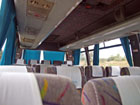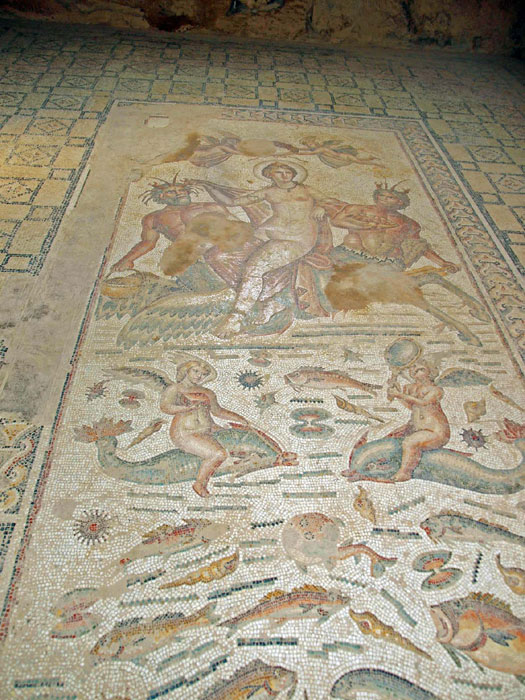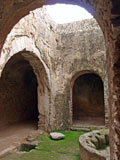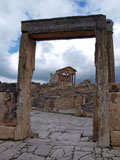FRANKFURT | CASABLANCA | ROAD TO FEZ | FEZ | ROAD TO ERFOUD | ONWARD TO OUARZAZATE | ROAD TO MARRAKECH | MARRAKECH | TUNISIA | CARTHAGE | DOUGGA/BULLA REGIA | DUBAI | AL MAHA | OMAN | SALALAH |
TUNISIA Day 3: DOUGGA/BULLA REGIA Abdi, our guide's, response to our complaint about the run down, stalling van provided the first day was to meet us in a 25 passenger tour bus dedicated to us alone. It was all they could think of to give us space and comfort. We felt a little silly but not silly enough to complain again. Abdi, our guide's, response to our complaint about the run down, stalling van provided the first day was to meet us in a 25 passenger tour bus dedicated to us alone. It was all they could think of to give us space and comfort. We felt a little silly but not silly enough to complain again.
Today's tours were to two ancient Roman cities, Bulla Regia and Dougga. They were located a considerable distance from Tunis so we spent the day doing a large circle tour through northwest Tunisia.  Bulla Regia was an ancient market city located in rich farmland area about 80 or so miles outside of Tunis. This site is still being excavated and so many of the ancient homes and other urban structures are still under centuries of dirt. But what has been exposed is quite interesting. The stone ruins which comprised the market area on the old road (which is now the modern asphalt road) is so so. But behind the market area are huge villas Bulla Regia was an ancient market city located in rich farmland area about 80 or so miles outside of Tunis. This site is still being excavated and so many of the ancient homes and other urban structures are still under centuries of dirt. But what has been exposed is quite interesting. The stone ruins which comprised the market area on the old road (which is now the modern asphalt road) is so so. But behind the market area are huge villas  that have an interesting feature. Mosaic tiles that covered the floors of these villas are still in incredible shape some 2,000 years later (picture at right). While it was cold today when we visited, Bulla Regia gets as hot as 120 degrees in the summer months. To deal with this, the rich villa owners created a two story home, one at ground level and the second completely underground (although with "skylights" to let in a bit of light; Abdi told us that Romans were very afraid of the dark and even during the day put candles around the rooms in this well-skylighted lower area). This lower floor was constructed with vaulted ceilings 20 or more feet in height, with mosaic floors, frescoed walls and adorned with statutes. The villa in the picture (above left) had an extra large opening. The "underground" rooms could stay cool even with a large opening that allowed for light, a garden and a sunlit pool area on that level. that have an interesting feature. Mosaic tiles that covered the floors of these villas are still in incredible shape some 2,000 years later (picture at right). While it was cold today when we visited, Bulla Regia gets as hot as 120 degrees in the summer months. To deal with this, the rich villa owners created a two story home, one at ground level and the second completely underground (although with "skylights" to let in a bit of light; Abdi told us that Romans were very afraid of the dark and even during the day put candles around the rooms in this well-skylighted lower area). This lower floor was constructed with vaulted ceilings 20 or more feet in height, with mosaic floors, frescoed walls and adorned with statutes. The villa in the picture (above left) had an extra large opening. The "underground" rooms could stay cool even with a large opening that allowed for light, a garden and a sunlit pool area on that level.
Dougga was quite a large city, with villas, gardens, streets, temples, baths,  and two amphitheaters. Like Carthage, it is a World Heritage site and has seen extensive excavation and some restoration. The Temple to Zeus, Minerva, and Juno is in as good shape as any in Rome. It is amazing how well the sites are preserved, particularly if you realize that these cities were sacked, often multiple times, and when they weren't being sacked they were being neglected in terms of preservation. A walk through the city, which had acres of urban development (it was a city of some 20,000 people) and a fully developed fresh water and sewer system, with a highly advanced architectural and structural style, makes one really understand that Romans really believed that they were building cities that would last forever. and two amphitheaters. Like Carthage, it is a World Heritage site and has seen extensive excavation and some restoration. The Temple to Zeus, Minerva, and Juno is in as good shape as any in Rome. It is amazing how well the sites are preserved, particularly if you realize that these cities were sacked, often multiple times, and when they weren't being sacked they were being neglected in terms of preservation. A walk through the city, which had acres of urban development (it was a city of some 20,000 people) and a fully developed fresh water and sewer system, with a highly advanced architectural and structural style, makes one really understand that Romans really believed that they were building cities that would last forever.
|
| TURKEY AND GREECE | CIRCLE THE ARCTIC |